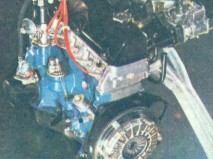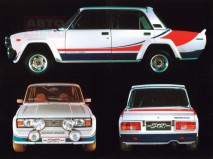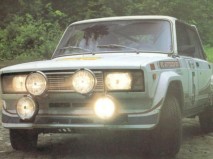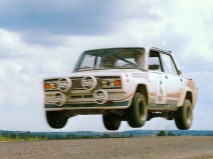0 VAZ-2105 VFTS
The exterior of the sport VAZ-2105 turned out bright and recognizable – the automobile found identity. The designers V. Ulitskas and A. Volungyavichus had worked over the exterior very well. The car was decorated with a smart “luster” of four additive headlamps in the front. The angular wheel-arch trims harmonized perfectly well with the rectangular headlamps, and with more distinct drawn in, emphatically faceted body contour in comparison to the former Zhiguli models. The front wheel-arch trims “flew” into the front spoiler combining them. Another two spoilers were thought over excellently, they dissipated air stream on the rear verge of the roof and on the car boot. The car looked wonderfully on its alloy discs of the German firm ATS – although they were set not for the sake of esthetics, but fighting with unnecessary kilograms of unsprung weights.
The engine was actually built anew in Vilnius. The bent shaft was grinded finely and balanced three times: at first single, then in assembly with a fly wheel and clutch. The fly wheel was made unique – sturdy and light. The rods were also grinded finely. The rod end was milled for compression ratio increase up to 10.5-11.5, depending on the petroleum quality in the country, which the automobile would get into. The valve diameter was enhanced, the blow-off of the plug with an explosive mixture, mixture induction and blow-out were projected. The explosive mixture was prepared by a pair of horizontal carburetors “Veber”. The distributor shaft was made anew. The oil crankcase grew in the volume from 4.2 to 7.5 l.
The titanium was employed in the hubs to reduce unsprung weights. Even the transmission ratio of the steering drive was corrected by changes and length selection of the steering links. The shock absorbers were bought at German firm Bilstein. The brake lines were laid into a special duct as well as lines. Electronic pointless ignition system appeared on rally cars much earlier than on civil cars.
Long-term experiments with the purpose to reduce the weight of the body made possible to lower by 80 kg the kurb weight of the sport car as compared to the commercial one. The maximum speed under the passport was stated 192 km/h, but the VFTS cars drove out steadily all 200. The VFTS built about 200 rally “Fives” a year. The “Fives” from Vilnius went along rally traces, probably on all the continents of the planet. The crews of the VFTS won absolute and took medal places in numberless rallies in the Soviet Union. Many victories were got driving these cars in Europe.
The company Simonov Motors from Moscow showed two replicas of VAZ-2105 VFTS at once at the exhibition Oldtimer Gallery.















